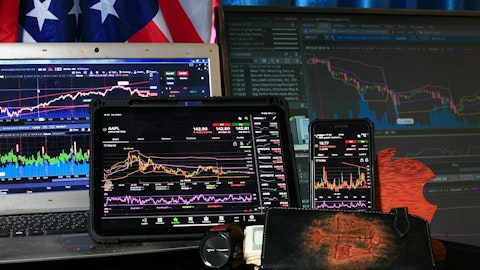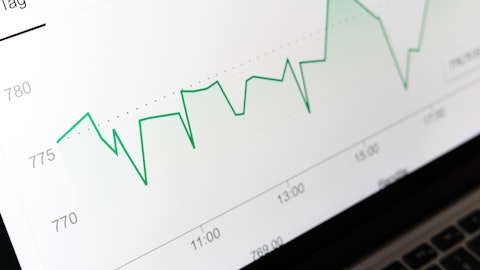In this article, we will take a look at the top 5 lowest P/E ratios of the S&P 500. To see more such companies, go directly to Top 30 Lowest P/E Ratios of the S&P 500.
5. Comerica Incorporated (NYSE:CMA)
PE Ratio as of November 13: 4.68
Comerica Incorporated (NYSE:CMA) has a dividend yield of over 6% as of November 13. Of the 910 hedge funds in Insider Monkey’s database of hedge funds, 46 hedge funds had stakes in Comerica Incorporated (NYSE:CMA). The biggest stakeholder of Comerica Incorporated (NYSE:CMA) was Ken Griffin’s Citadel Investment Group which owns a $90 million stake in the company.
Third Avenue Value Fund made the following comment about Comerica Incorporated (NYSE:CMA) in its first quarter 2023 investor letter:
“The largest detractors from Fund performance during the quarter included two banks, Comerica Incorporated (NYSE:CMA) and Deutsche Bank. As it relates to the Fund specifically, events within U.S. banking applied most directly to our investment in Comerica, a U.S. super-regional that does have a large portion of corporate deposits and is not classified as a globally systemically important bank (“G-SIB”), which means it has not recognized certain mark-to-market securities losses in its regulatory capital. Comerica was a 2.6% position at the beginning of the quarter, prior to a roughly 34% stock price decline during the quarter. After purchasing more shares following the stock price decline, the Fund’s position in Comerica was approximately 2.3% at quarter end. While the general contagion fears and bank depositor behavior remain a fluid situation today, we took some confidence from immediate, forceful and targeted actions by the Fed, FDIC and Treasury. In our view, the Fed’s Bank Term Funding Program (“BTFP”) seems a well-tailored and appropriate near-term liquidity solution that allows banks to obtain immediate liquidity, collateralized by the par value of securities, to meet any near-term deposit outflows. At the time of this writing, early signs are that the deposit flight from regional banks is calming rapidly and depositor psychology is improving, though this could change. To the extent that calming continues, our suspicion is that there may be very attractive bargains to be had among regional banks. More will be known in the coming days and weeks as information regarding deposit flows emanates post-quarter end. That said, there will remain some mystery around the extent of the bargains on offer because increases in FDIC funding, increases in regulatory capital requirements, more stringent liquidity stress testing, and changes to the list of banks subject to G-SIB regulatory regimes are all on the table now. It is also very likely that deposit costs, which had been rising very slowly, will rise much more rapidly as commercial banks work harder to entice depositors to stay put. None of these developments, if they eventuate, are likely to impact banks’ returns and earnings in a positive way.
More broadly, the Third Avenue Value Fund owned investments categorized as financials totaling 15.94% by weight, at quarter end. This category includes non-bank financials such as Old Republic, a U.S. property and casualty insurer and title insurance business, Lazard, an advisory business and asset management firm, and Ashmore, a U.K. asset management firm specializing in emerging markets credit. The Fund’s actual bank exposure at quarter end totaled 9.52% and is comprised of Bank of Ireland, Deutsche Bank and Comerica, in order of position size…” (Click here to read the full text)
4. United Airlines Holdings, Inc. (NASDAQ:UAL)
PE Ratio as of November 13: 4.41
United Airlines Holdings, Inc. (NASDAQ:UAL) ranks 4th in our list of the top stocks with the lowest PE rations in the S&P 500 index. In the third quarter, United Airlines Holdings, Inc. (NASDAQ:UAL)’s adjusted EPS in the period came in at $3.65, surpassing estimates by $0.24. Revenue in the quarter jumped about 12.4% year over year to $14.48 billion, beating estimates by $70 million.
3. Valero Energy Corporation (NYSE:VLO)
PE Ratio as of November 13: 4.18
Valero Energy Corporation (NYSE:VLO) shares are up about 2% year to date through November 13. Valero Energy Corporation (NYSE:VLO)’s dividend yield is about 3.3%. As of the end of the second quarter of 2023, 49 hedge funds had stakes in Valero Energy Corporation (NYSE:VLO). The most significant stake in Valero Energy Corporation (NYSE:VLO) is owned by Lee Munder’s Lee Munder Capital Group which owns an $11.6 million stake in the company.
2. Albemarle Corporation (NYSE:ALB)
PE Ratio as of November 13: 4.15
Albemarle Corporation (NYSE:ALB) shares have lost about 63% over the past one year.
The London Company Large Cap Strategy made the following comment about Albemarle Corporation (NYSE:ALB) in its Q3 2023 investor letter:
“Albemarle Corporation (NYSE:ALB) – ALB underperformed due to declining lithium spot prices in the quarter. We remain attracted to ALB, reflecting its low cost position in two consolidated industries (lithium & bromine). However, we recognize quarterly results can be volatile, driven by short-term supply-demand dynamics for the underlying commodities. It is important to note that ALB’s favorable position on the cost curve means the company can likely maintain healthy profitability even at trough prices.”
1. General Motors Company (NYSE:GM)
PE Ratio as of November 13: 3.77
General Motors Company (NYSE:GM) is one of the top stocks with the lowest PE ratios in the S&P 500 index. As of the end of the second quarter of 2023, 72 hedge funds tracked by Insider Monkey had stakes in General Motors Company (NYSE:GM). The biggest stakeholder of General Motors Company (NYSE:GM) was Ric Dillon’s Diamond Hill Capital which owns a $390 million stake in the company.
Patient Capital Opportunity Equity Strategy made the following comment about General Motors Company (NYSE:GM) in its Q2 2023 investor letter:
“We like other names mostly ignored by the market for similar reasons. Names like Expedia (EXPE), General Motors Company (NYSE:GM), and Delta Air Lines. These companies have strong returns on capital (14%+), good competitive positions, cheap valuations (all double-digit free cash flow yields), and are returning capital to shareholders. We trust the managements to take advantage of their depressed stock prices and create long-term shareholder value.”
You can also take a peek at 11 Undervalued Mid Cap Stocks To Buy According to Analysts and 12 Most Important Holidays in the US.




